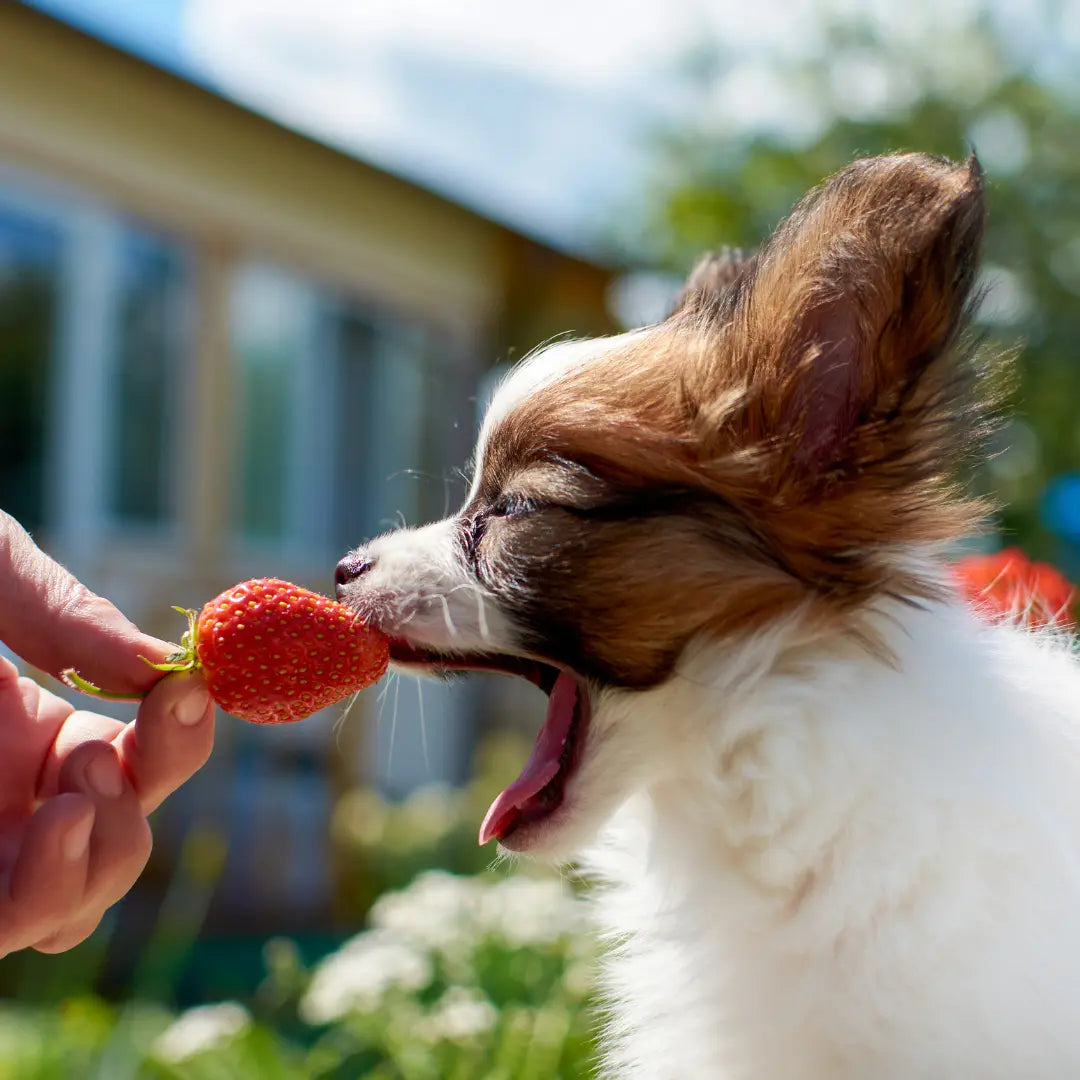What Vegetable Peels & Stalks are Safe and Not Safe for your Dog?
You may not know it, but your dog can eat more than just the flesh of vegetables - they can also enjoy stems and peels! Rather than tossing the stalk or top of a carrot into the compost, these can be healthy treats for your dog and reduce food waste at home. Read on to find out what vegetables you can feed your dog, along with tips on how best to prepare them.
Learn more about what vegetables your dog can eat and which ones to stay clear of.
Broccoli Stems for Dogs - YES
Did you know that broccoli is one of the vegetables dogs love the most. Broccoli stems are a great source of vitamins and minerals for your pup, both cooked and raw! It is high in fiber and vitamin C, and low in fat. However, the florets contain isothiocyanates, which can cause gastric irritation in dogs in larger quantities. For this reason, broccoli stems can be used instead. Before serving any broccoli to your dog, best to cut the stem into smaller pieces to reduce the risk of choking. Broccoli stems are known for lodging in a dog's esophagus - especially in smaller breeds - so be sure to keep an eye out if you're choosing to feed broccoli! Another way to serve is by pureeing the broccoli, adding some water and steaming, then blending together. If you’re looking to cook your own dog food at home, check out our Chicken Pot Pie for Dogs - this is a great homemade treat packed with broccoli.
Cauliflower Stalks for Dogs - NO
While cauliflower is a nutrient powerhouse. Packed with fiber, vitamins and minerals like vitamin C, vitamin K, calcium, potassium and folate, this low-calorie vegetable can provide valuable nutrients to your pup's diet if fed only in moderation. It is highly recommended not to feed the stalk of this vegetable as it is especially fibrous and may cause gastrointestinal issues when ingested and could be a choking hazard. Best to stick to the florets. The leaves are another part of the vegetable that is safe to add to your dog’s diet. Gently cooking helps with the digestion of this vegetable. If you’re looking for a home-cooked meal for your dog, our Chickpea Cauliflower Bowl is a great meatless Monday recipe for dogs.
Sweet Potato Skins for Dogs - YES
Sweet potatoes are tasty and nutritious for both humans and dogs alike. The skin of a sweet potato contains plenty of vitamins and minerals beneficial to your dog, but sweet potatoes should always be cooked prior to serving. As with anything, moderation is key, as the skin can be hard to digest and if consumed in large chunks may present a choking hazard for small breed dogs. It is safest to slice or cut into small, thin pieces before feeding your pup. Whether you bake, steam or mash the sweet potatoes for your beloved pet, leaving the skin on could provide an added nutritional boost. Our sweet potato air fryer chips are a favorite recipe to cook for your dog. Why pay for sweet potato dog treats when you can easily cook them at home? Try out our cheap, easy Sweet Potato Treats that cost less than 2 cents a treat!
Asparagus Stalks for Dogs - NO
It's great to know that dogs can enjoy the same vegetable treats that people do with asparagus. Although cooked asparagus is safe for dogs to eat and generally easy for them to digest, it's best to trim off the tough ends of the stalks before feeding it to your pup so it doesn't cause any choking. However, you should avoid feeding raw asparagus as its high fiber content may be difficult for some dogs to digest. Additionally, you need to be careful when growing asparagus in your own garden, as the seeds can be poisonous to both humans and dogs if ingested. Vomiting, diarrhea and stomach pains can all occur if a dog eats seeds. Fortunately, keeping a sturdy fence around your garden will prevent your pets from getting into trouble!
Spinach Stems - MAYBE
Spinach is a popular superfood that is high in vitamins and minerals, including vitamins A, B, C, and K. It also contains iron and has powerful antioxidants like beta-carotene, which can help keep our bodies healthy. But it does contain a considerable amount of oxalic acid which can block the body’s ability to absorb calcium in large quantities - though it isn't an issue for healthy canine kidneys. For dogs already prone to kidney or bladder stones, however, spinach might be best avoided as long-term consumption of this otherwise beneficial vegetable can lead to kidney stress, muscle weakness, abnormal heart rhythms and even respiratory paralysis. If you’re looking to cook for your dog look no further than our Broccoli Stems and Chicken Pucks recipe for dogs.
Carrot Tops - YES
Carrot tops are an often overlooked not only do they provide a strong source of fiber and antioxidants, but also, as any pet owner would know, they're rich in vitamins and minerals. For example, carrots are naturally full of beta-carotene, which is converted into vitamin A in the body! Vitamin K and potassium are also part of the carrot-package, both essential for doggy health. Plus, these bright orange vegetables can be served raw, cooked or frozen as a chew - you can even serve them with their leafy tops still attached! Additionally, their natural sweetness makes them enjoyable for even the pickiest of pups! Try soaking a carrot in a sodium and onion-free broth for an hour and freeze as a special all-natural dental chew. If you’re ready to start cooking meals for your dog, our Dog Salmon Fried Rice uses carrot tops.
Celery Stalks for Dogs - YES
Celery stalks offer another fantastic, crunchy option for your dog to enjoy. It is low in calories but rich in hydration and fiber, so celery can be a refreshing snack, especially during warmer weather. It’s also packed with vitamins A, B, and C, which can help improve your dog’s heart health and even freshen their breath! Freshpet reviews highlight the importance of choosing safe and healthy treats, and celery meets these criteria well when prepared correctly. Always introduce new foods like celery gradually to monitor how your pet’s digestive system handles it.
Kale Stems - MAYBE
Kale is a nutrient-rich vegetable that can be a beneficial addition to the diets of many dogs. With its high levels of vitamins, such as Vitamin A, kale helps your pet maintain healthy skin and increase its immunity. The stems can make a great snack.
Tomato Stems for Dogs - NO
While tomatoes are generally considered nontoxic and can be served as an occasional treat to your pup, it's important to understand the risks associated with them. Tomato plants are part of the nightshade family of vegetables and contain solanine and tomatine toxins which can be harmful if ingested. Therefore, your dog should never eat leaves or stems from the tomato plant, nor should they consume unripe (green) tomatoes. However, ripe red tomatoes in moderation can actually offer some health benefits for your dog such as dietary fiber and essential minerals that can help support their digestion.
Avocado Skin - NO
The flesh of an avocado contains vitamins and fatty acids that may assist a dog with digestion, as well as enhance its coat and skin. However, avocados are high in fat, which can cause an upset stomach and possibly pancreatitis in some dogs—even when they consume just a small amount of avocado pulp. Furthermore, the pit in a ripe avocado doesn’t digest very well in a dog’s body, thus increasing the risk of gastric or intestinal blockages. Finally, although the known toxin persin found in an avocado will not affect dogs and cats too much, other species may become ill from ingestion. Dog owners should exercise caution when feeding avocados to their pets and remember that even this seemingly harmless fruit has potential hazards.
Onion - NEVER
Onions and their relatives, like shallots and chives, can have serious repercussions for our furry friends. In fact, all parts of the onion plant are toxic to dogs, and this includes the leaves, juice, flesh and even processed powders found in a diverse range of human food items from broths to baby food. The toxicity of onions is so severe that just 100 grams (about the size of a medium onion) per 20 kilograms of a dog's weight can cause damaging effects. One medium-to-large onion is enough to cause hazardous levels of toxicity in a 45-pound dog and onion poisoning can take up to 7 days to show up. It is important to check labels before giving human food to your dog, as even in small amounts it can be deadly
Here is how to best prepare and serve vegetables for your dog
- Organic – Fruits and vegetables are an important part of a dog’s diet, and organic produce is the best option for your pup.
- Wash veggies – Thoroughly rinse them before you feed them to remove as many harmful pesticides as possible.
- Cooked, steamed, or raw – You can cook, steam, or serve it raw depending on what your pup prefers. Cooked and steamed veggies are easier for your dog to digest. Avoid fried or deep-fried vegetables and always steer clear of spices, especially since they can contain onion powder.
- Puree or Chop – To aid digestion, especially when introducing new foods into their diet, blend up or puree the produce before you feed it to them. Always chop to the appropriate size to avoid choking and best to monitor your dog when they are munching on vegetables.
- Balanced diet – In order to provide a balanced diet, always pair vegetables with a source of protein like chicken or beef. To create complete and balanced meals Dog Child’s Essential Nutrient Mix can be added to home cooked meals to provide all the essential nutrients for a balanced diet.
- Be careful with new foods – Introduce any new food gradually – biting off more than they can chew isn't good for anyone!
Mixed Veggie Meal Mix
At Dog Child we are passionate about reducing food waste, so we encourage pet parents to always think about food before they throw it away. Check if you can safely cook for your dog. We have lots of recipes that show you how to upcycle vegetables. Also our Mixed Veggie Meal Mix is made with human grade upcycled organic vegetables which save kilograms of food waste each year.
Upcycling vegetable scraps doesn't have to be complicated—as long as you prepare them properly first! There are plenty of vegetables that offer up edible parts beyond the edible florets or fleshy bits we typically eat. Don't forget that dogs don't care what color their food is, so there's no need to worry about removing those tough outer layers from squash or carrots before feeding them as treats! With a little creativity and careful selection, you can turn these otherwise wasted scraps into tasty treats for your furry friend. Just remember to check with your vet before introducing anything new into their diets!











